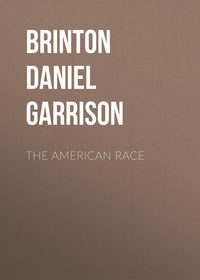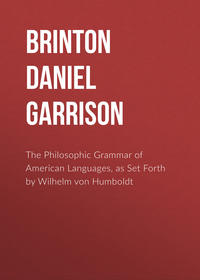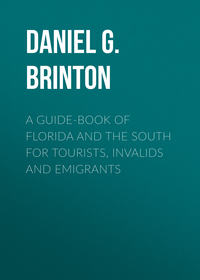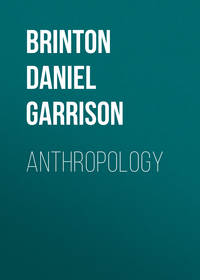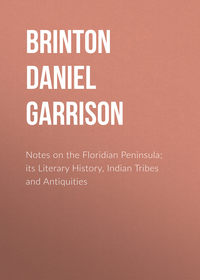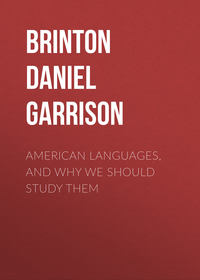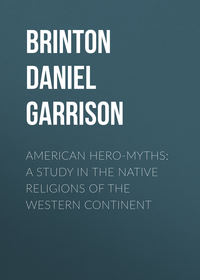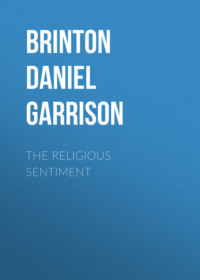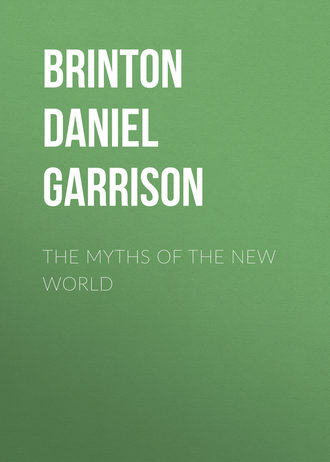 полная версия
полная версияThe Myths of the New World
The descent is, indeed, almost imperceptible which leads to the personification of the wind as God, which merges this manifestation of life and power in one with its unseen, unknown cause. Thus it was a worthy epithet which the Creeks applied to their supreme invisible ruler, when they addressed him as Esaugetuh Emissee, Master of Breath, and doubtless it was at first but a title of equivalent purport which the Cherokees, their neighbors, were wont to employ, Oonawleh unggi, Eldest of Winds, but rapidly leading to a complete identification of the divine with the natural phenomena of meteorology. This seems to have taken place in the same group of nations, for the original Choctaw word for Deity was Hushtoli, the Storm Wind.43 The idea, indeed, was constantly being lost in the symbol. In the legends of the Quiches, the mysterious creative power is Hurakan, a name of no signification in their language, one which their remote ancestors brought with them from the Antilles, which finds its meaning in the ancient tongue of Haiti, and which, under the forms of hurricane, ouragan, orkan, was adopted into European marine languages as the native name of the terrible tornado of the Caribbean Sea.44 Mixcohuatl, the Cloud Serpent, chief divinity of several tribes in ancient Mexico, is to this day the correct term in their language for the tropical whirlwind, and the natives of Panama worshipped the same phenomenon under the name Tuyra.45 To kiss the air was in Peru the commonest and simplest sign of adoration to the collective divinities.46
Many writers on mythology have commented on the prominence so frequently given to the winds. None have traced it to its true source. The facts of meteorology have been thought all sufficient for a solution. As if man ever did or ever could draw the idea of God from nature! In the identity of wind with breath, of breath with life, of life with soul, of soul with God, lies the far deeper and far truer reason, whose insensible development I have here traced, in outline indeed, but confirmed by the evidence of language itself.
Let none of these expressions, however, be construed to prove the distinct recognition of One Supreme Being. Of monotheism either as displayed in the one personal definite God of the Semitic races, or in the dim pantheistic sense of the Brahmins, there was not a single instance on the American continent. The missionaries found no word in any of their languages fit to interpret Deus, God. How could they expect it? The associations we attach to that name are the accumulated fruits of nigh two thousand years of Christianity. The phrases Good Spirit, Great Spirit, and similar ones, have occasioned endless discrepancies in the minds of travellers. In most instances they are entirely of modern origin, coined at the suggestion of missionaries, applied to the white man’s God. Very rarely do they bring any conception of personality to the native mind, very rarely do they signify any object of worship, perhaps never did in the olden times. The Jesuit Relations state positively that there was no one immaterial god recognized by the Algonkin tribes, and that the title, the Great Manito, was introduced first by themselves in its personal sense.47 The supreme Iroquois Deity Neo or Hawaneu, triumphantly adduced by many writers to show the monotheism underlying the native creeds, and upon whose name Mr. Schoolcraft has built some philological reveries, turns out on closer scrutiny to be the result of Christian instruction, and the words themselves to be but corruptions of the French Dieu and le bon Dieu!48
Innumerable mysterious forces are in activity around the child of nature; he feels within him something that tells him they are not of his kind, and yet not altogether different from him; he sums them up in one word drawn from sensuous experience. Does he wish to express still more forcibly this sentiment, he doubles the word, or prefixes an adjective, or adds an affix, as the genius of his language may dictate. But it still remains to him but an unapplied abstraction, a mere category of thought, a frame for the All. It is never the object of veneration or sacrifice, no myth brings it down to his comprehension, it is not installed in his temples. Man cannot escape the belief that behind all form is one essence; but the moment he would seize and define it, it eludes his grasp, and by a sorcery more sadly ludicrous than that which blinded Titania, he worships not the Infinite he thinks but a base idol of his own making. As in the Zend Avesta behind the eternal struggle of Ormuzd and Ahriman looms up the undisturbed and infinite Zeruana Akerana, as in the pages of the Greek poets we here and there catch glimpses of a Zeus who is not he throned on Olympus, nor he who takes part in the wrangles of the gods, but stands far off and alone, one yet all, “who was, who is, who will be,” so the belief in an Unseen Spirit, who asks neither supplication nor sacrifice, who, as the natives of Texas told Joutel in 1684, “does not concern himself about things here below,”49 who has no name to call him by, and is never a figure in mythology, was doubtless occasionally present to their minds. It was present not more but far less distinctly and often not at all in the more savage tribes, and no assertion can be more contrary to the laws of religious progress than that which pretends that a purer and more monotheistic religion exists among nations devoid of mythology. There are only two instances on the American continent where the worship of an immaterial God was definitely instituted, and these as the highest conquests of American natural religions deserve especial mention.
They occurred, as we might expect, in the two most civilized nations, the Quichuas of Peru, and the Nahuas of Tezcuco. It is related that about the year 1440, at a grand religious council held at the consecration of the newly-built temple of the Sun at Cuzco, the Inca Yupanqui rose before the assembled multitude and spoke somewhat as follows:—
“Many say that the Sun is the Maker of all things. But he who makes should abide by what he has made. Now many things happen when the Sun is absent; therefore he cannot be the universal creator. And that he is alive at all is doubtful, for his trips do not tire him. Were he a living thing, he would grow weary like ourselves; were he free, he would visit other parts of the heavens. He is like a tethered beast who makes a daily round under the eye of a master; he is like an arrow, which must go whither it is sent, not whither it wishes. I tell you that he, our Father and Master the Sun, must have a lord and master more powerful than himself, who constrains him to his daily circuit without pause or rest.”50
To express this greatest of all existences, a name was proclaimed, based upon that of the highest divinities known to the ancient Aymara race, Illatici Viracocha Pachacamac, literally, the thunder vase, the foam of the sea, animating the world, mysterious and symbolic names drawn from the deepest religious instincts of the soul, whose hidden meanings will be unravelled hereafter. A temple was constructed in a vale by the sea near Callao, wherein his worship was to be conducted without images or human sacrifices. The Inca was ahead of his age, however, and when the Spaniards visited the temple of Pachacamac in 1525, they found not only the walls adorned with hideous paintings, but an ugly idol of wood representing a man of colossal proportions set up therein, and receiving the prayers of the votaries.51
No better success attended the attempt of Nezahuatl, lord of Tezcuco, which took place about the same time. He had long prayed to the gods of his forefathers for a son to inherit his kingdom, and the altars had smoked vainly with the blood of slaughtered victims. At length, in indignation and despair, the prince exclaimed, “Verily, these gods that I am adoring, what are they but idols of stone without speech or feeling? They could not have made the beauty of the heaven, the sun, the moon, and the stars which adorn it, and which light the earth, with its countless streams, its fountains and waters, its trees and plants, and its various inhabitants. There must be some god, invisible and unknown, who is the universal creator. He alone can console me in my affliction and take away my sorrow.” Strengthened in this conviction by a timely fulfilment of his heart’s desire, he erected a temple nine stories high to represent the nine heavens, which he dedicated “to the Unknown God, the Cause of Causes.” This temple, he ordained, should never be polluted by blood, nor should any graven image ever be set up within its precincts.52
In neither case, be it observed, was any attempt made to substitute another and purer religion for the popular one. The Inca continued to receive the homage of his subjects as a brother of the sun, and the regular services to that luminary were never interrupted. Nor did the prince of Tezcuco afterwards neglect the honors due his national gods, nor even refrain himself from plunging the knife into the breasts of captives on the altar of the god of war.53 They were but expressions of that monotheism which is ever present, “not in contrast to polytheism, but in living intuition in the religious sentiments.” If this subtle but true distinction be rightly understood, it will excite no surprise to find such epithets as “endless,” “omnipotent,” “invisible,” “adorable,” such appellations as “the Maker and Moulder of All,” “the Mother and Father of Life,” “the One God complete in perfection and unity,” “the Creator of all that is,” “the Soul of the World,” in use and of undoubted indigenous origin not only among the civilized Aztecs, but even among the Haitians, the Araucanians, the Lenni Lenape, and others.54 It will not seem contradictory to hear of them in a purely polytheistic worship; we shall be far from regarding them as familiar to the popular mind, and we shall never be led so far astray as to adduce them in evidence of a monotheism in either technical sense of that word. In point of fact they were not applied to any particular god even in the most enlightened nations, but were terms of laudation and magniloquence used by the priests and devotees of every several god to do him honor. They prove something in regard to a consciousness of divinity hedging us about, but nothing at all in favor of a recognition of one God; they exemplify how profound is the conviction of a highest and first principle, but they do not offer the least reason to surmise that this was a living reality in doctrine or practice.
The confusion of these distinct ideas has led to much misconception of the native creeds. But another and more fatal error was that which distorted them into a dualistic form, ranging on one hand the good spirit with his legions of angels, on the other the evil one with his swarms of fiends, representing the world as the scene of their unending conflict, man as the unlucky football who gets all the blows. This notion, which has its historical origin among the Parsees of ancient Iran, is unknown to savage nations. “The idea of the Devil,” justly observes Jacob Grimm, “is foreign to all primitive religions.” Yet Professor Mueller, in his voluminous work on those of America, after approvingly quoting this saying, complacently proceeds to classify the deities as good or bad spirits!55
This view, which has obtained without question in every work on the native religions of America, has arisen partly from habits of thought difficult to break, partly from mistranslations of native words, partly from the foolish axiom of the early missionaries, “The gods of the gentiles are devils.” Yet their own writings furnish conclusive proof that no such distinction existed out of their own fancies. The same word (otkon) which Father Bruyas employs to translate into Iroquois the term “devil,” in the passage “the Devil took upon himself the figure of a serpent,” he is obliged to use for “spirit” in the phrase, “at the resurrection we shall be spirits,”56 which is a rather amusing illustration how impossible it was by any native word to convey the idea of the spirit of evil. When, in 1570, Father Rogel commenced his labors among the tribes near the Savannah River, he told them that the deity they adored was a demon who loved all evil things, and they must hate him; whereupon his auditors replied, that so far from this being the case, whom he called a wicked being was the power that sent them all good things, and indignantly left the missionary to preach to the winds.57
A passage often quoted in support of this mistaken view is one in Winslow’s “Good News from New England,” written in 1622. The author says that the Indians worship a good power called Kiehtan, and another “who, as farre as wee can conceive, is the Devill,” named Hobbamock, or Hobbamoqui. The former of these names is merely the word “great,” in their dialect of Algonkin, with a final n, and is probably an abbreviation of Kittanitowit, the great manito, a vague term mentioned by Roger Williams and other early writers, not the appellation of any personified deity.58 The latter, so far from corresponding to the power of evil, was, according to Winslow’s own statement, the kindly god who cured diseases, aided them in the chase, and appeared to them in dreams as their protector. Therefore, with great justice, Dr. Jarvis has explained it to mean “the oke or tutelary deity which each Indian worships,” as the word itself signifies.59
So in many instances it turns out that what has been reported to be the evil divinity of a nation, to whom they pray to the neglect of a better one, is in reality the highest power they recognize. Thus Juripari, worshipped by certain tribes of the Pampas of Buenos Ayres, and said to be their wicked spirit, is in fact the only name in their language for spiritual existence in general; and Aka-kanet, sometimes mentioned as the father of evil in the mythology of the Araucanians, is the benign power appealed to by their priests, who is throned in the Pleiades, who sends fruits and flowers to the earth, and is addressed as “grandfather.”60 The Çupay of the Peruvians never was, as Prescott would have us believe, “the shadowy embodiment of evil,” but simply and solely their god of the dead, the Pluto of their pantheon, corresponding to the Mictla of the Mexicans.
The evidence on the point is indeed conclusive. The Jesuit missionaries very rarely distinguish between good and evil deities when speaking of the religion of the northern tribes; and the Moravian Brethren among the Algonkins and Iroquois place on record their unanimous testimony that “the idea of a devil, a prince of darkness, they first received in later times through the Europeans.”61 So the Cherokees, remarks an intelligent observer, “know nothing of the Evil One and his domains, except what they have learned from white men.”62 The term Great Spirit conveys, for instance, to the Chipeway just as much the idea of a bad as of a good spirit; he is unaware of any distinction until it is explained to him.63 “I have never been able to discover from the Dakotas themselves,” remarks the Rev. G. H. Pond, who had lived among them as a missionary for eighteen years,64 “the least degree of evidence that they divide the gods into classes of good and evil, and am persuaded that those persons who represent them as doing so, do it inconsiderately, and because it is so natural to subscribe to a long cherished popular opinion.”
Very soon after coming in contact with the whites, the Indians caught the notion of a bad and good spirit, pitted one against the other in eternal warfare, and engrafted it on their ancient traditions. Writers anxious to discover Jewish or Christian analogies, forcibly construed myths to suit their pet theories, and for indolent observers it was convenient to catalogue their gods in antithetical classes. In Mexican and Peruvian mythology this is so plainly false that historians no longer insist upon it, but as a popular error it still holds its ground with reference to the more barbarous and less known tribes.
Perhaps no myth has been so often quoted in its confirmation as that of the ancient Iroquois, which narrates the conflict between the first two brothers of our race. It is of undoubted native origin and venerable antiquity. The version given by the Tuscarora chief Cusic in 1825, relates that in the beginning of things there were two brothers, Enigorio and Enigohahetgea, names literally meaning the Good Mind and the Bad Mind.65 The former went about the world furnishing it with gentle streams, fertile plains, and plenteous fruits, while the latter maliciously followed him creating rapids, thorns, and deserts. At length the Good Mind turned upon his brother in anger, and crushed him into the earth. He sank out of sight in its depths, but not to perish, for in the dark realms of the underworld he still lives, receiving the souls of the dead and being the author of all evil. Now when we compare this with the version of the same legend given by Father Brebeuf, missionary to the Hurons in 1636, we find its whole complexion altered; the moral dualism vanishes; the names Good Mind and Bad Mind do not appear; it is the struggle of Ioskeha, the White one, with his brother Tawiscara, the Dark one, and we at once perceive that Christian influence in the course of two centuries had given the tale a meaning foreign to its original intent.
So it is with the story the Algonkins tell of their hero Manibozho, who, in the opinion of a well-known writer, “is always placed in antagonism to a great serpent, a spirit of evil.”66 It is to the effect that after conquering many animals, this famous magician tried his arts on the prince of serpents. After a prolonged struggle, which brought on the general deluge and the destruction of the world, he won the victory. The first authority we have for this narrative is even later than Cusic; it is Mr. Schoolcraft in our own day; the legendary cause of the deluge as related by Father Le Jeune, in 1634, is quite dissimilar, and makes no mention of a serpent; and as we shall hereafter see, neither among the Algonkins nor any other Indians, was the serpent usually a type of evil, but quite the reverse.67
The comparatively late introduction of such views into the native legends finds a remarkable proof in the myths of the Quiches, which were committed to writing in the seventeenth century. They narrate the struggles between the rulers of the upper and the nether world, the descent of the former into Xibalba, the Realm of Phantoms, and their victory over its lords, One Death and Seven Deaths. The writer adds of the latter, who clearly represent to his mind the Evil One and his adjutants, “in the old times they did not have much power; they were but annoyers and opposers of men, and in truth they were not regarded as gods. But when they appeared it was terrible. They were of evil, they were owls, fomenting trouble and discord.” In this passage, which, be it said, seems to have impressed the translators very differently, the writer appears to compare the great power assigned by the Christian religion to Satan and his allies, with the very much less potency attributed to their analogues in heathendom, the rulers of the world of the dead.68
A little reflection will convince the most incredulous that any such dualism as has been fancied to exist in the native religions, could not have been of indigenous growth. The gods of the primitive man are beings of thoroughly human physiognomy, painted with colors furnished by intercourse with his fellows. These are his enemies or his friends, as he conciliates or insults them. No mere man, least of all a savage, is kind and benevolent in spite of neglect and injury, nor is any man causelessly and ceaselessly malicious. Personal, family, or national feuds render some more inimical than others, but always from a desire to guard their own interests, never out of a delight in evil for its own sake. Thus the cruel gods of death, disease, and danger, were never of Satanic nature, while the kindliest divinities were disposed to punish, and that severely, any neglect of their ceremonies. Moral dualism can only arise in minds where the ideas of good and evil are not synonymous with those of pleasure and pain, for the conception of a wholly good or a wholly evil nature requires the use of these terms in their higher, ethical sense. The various deities of the Indians, it may safely be said in conclusion, present no stronger antithesis in this respect than those of ancient Greece and Rome.
CHAPTER III.
THE SACRED NUMBER, ITS ORIGIN AND APPLICATIONS
The number Four sacred in all American religions, and the key to their symbolism.—Derived from the Cardinal Points.—Appears constantly in government, arts, rites, and myths.—The Cardinal Points identified with the Four Winds, who in myths are the four ancestors of the human race, and the four celestial rivers watering the terrestrial Paradise.—Associations grouped around each Cardinal Point.—From the number four was derived the symbolic value of the number Forty, and the Sign of the Cross.
EVERY one familiar with the ancient religions of the world must have noticed the mystic power they attach to certain numbers, and how these numbers became the measures and formative quantities, as it were, of traditions and ceremonies, and had a symbolical meaning nowise connected with their arithmetical value. For instance, in many eastern religions, that of the Jews among the rest, seven was the most sacred number, and after it, four and three. The most cursory reader must have observed in how many connections the seven is used in the Hebrew Scriptures, occurring, in all, something over three hundred and sixty times, it is said. Why these numbers were chosen rather than others has not been clearly explained. Their sacred character dates beyond the earliest history, and must have been coeval with the first expressions of the religious sentiment. Only one of them, the FOUR, has any prominence in the religions of the red race, but this is so marked and so universal, that at a very early period in my studies I felt convinced that if the reason for its adoption could be discovered, much of the apparent confusion which reigns among them would be dispelled.
Such a reason must take its rise from some essential relation of man to nature, everywhere prominent, everywhere the same. It is found in the adoration of the cardinal points.
The red man, as I have said, was a hunter; he was ever wandering through pathless forests, coursing over boundless prairies. It seems to the white race not a faculty, but an instinct that guides him so unerringly. He is never at a loss. Says a writer who has deeply studied his character: “The Indian ever has the points of the compass present to his mind, and expresses himself accordingly in words, although it shall be of matters in his own house.”69
The assumption of precisely four cardinal points is not of chance; it is recognized in every language; it is rendered essential by the anatomical structure of the body; it is derived from the immutable laws of the universe. Whether we gaze at the sunset or the sunrise, or whether at night we look for guidance to the only star of the twinkling thousands that is constant to its place, the anterior and posterior planes of our bodies, our right hands and our left coincide with the parallels and meridians. Very early in his history did man take note of these four points, and recognizing in them his guides through the night and the wilderness, call them his gods. Long afterwards, when centuries of slow progress had taught him other secrets of nature—when he had discerned in the motions of the sun, the elements of matter, and the radicals of arithmetic a repetition of this number—they were to him further warrants of its sacredness. He adopted it as a regulating quantity in his institutions and his arts; he repeated it in its multiples and compounds; he imagined for it novel applications; he constantly magnified its mystic meaning; and finally, in his philosophical reveries, he called it the key to the secrets of the universe, “the source of ever-flowing nature.”70
In primitive geography the figure of the earth is a square plain; in the legend of the Quiché’s it is “shaped as a square, divided into four parts, marked with lines, measured with cords, and suspended from the heavens by a cord to its four corners and its four sides.”71 The earliest divisions of territory were in conformity to this view. Thus it was with ancient Egypt, Syria, Mesopotamia, and China;72 and in the new world, the states of Peru, Araucania, the Muyscas, the Quichés, and Tlascala were tetrarchies divided in accordance with, and in the first two instances named after, the cardinal points. So their chief cities—Cuzco, Quito, Tezcuco, Mexico, Cholula—were quartered by streets running north, south, east, and west. It was a necessary result of such a division that the chief officers of the government were four in number, that the inhabitants of town and country, that the whole social organization acquired a quadruplicate form. The official title of the Incas was “Lord of the four quarters of the earth,” and the venerable formality in taking possession of land, both in their domain and that of the Aztecs, was to throw a stone, to shoot an arrow, or to hurl a firebrand to each of the cardinal points.73 They carried out the idea in their architecture, building their palaces in squares with doors opening, their tombs with their angles pointing, their great causeways running in these directions. These architectural principles repeat themselves all over the continent; they recur in the sacred structures of Yucatan, in the ancient cemetery of Teo-tihuacan near Mexico, where the tombs are arranged along avenues corresponding exactly to the parallels and meridians of the central tumuli of the sun and moon;74 and however ignorant we are about the mound builders of the Mississippi valley, we know that they constructed their earthworks with a constant regard to the quarters of the compass.




